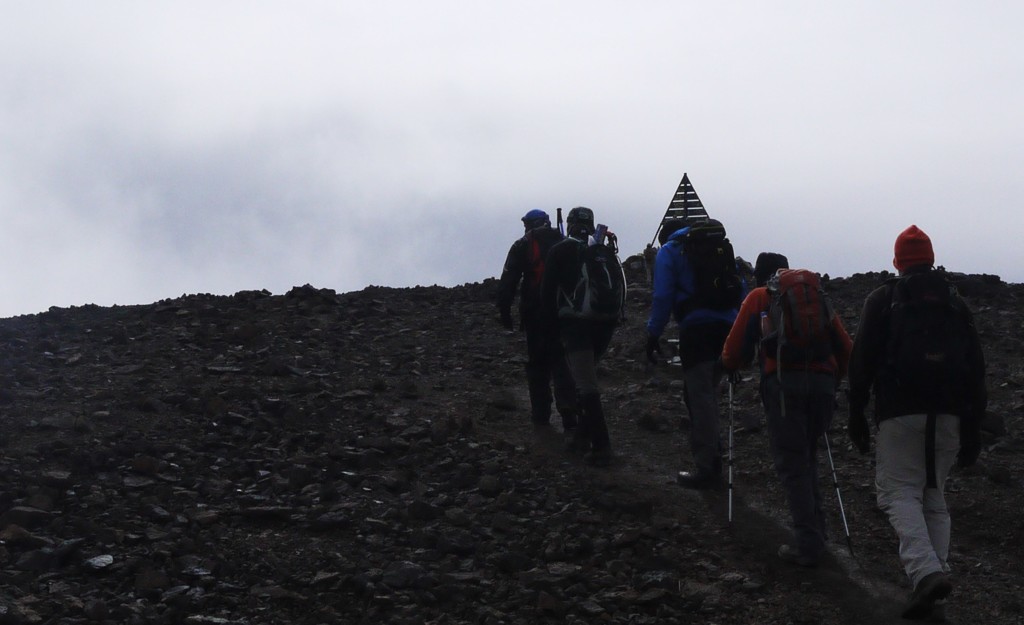After six months of training, I finally set off on my Atlas Mountain trek last week in a state of excitement and trepidation. Would all the hard work pay off? How would I cope with altitude sickness, the trots or a combination of both? And most importantly, would I make it to the summit of the mighty Mount Toubkal? All is revealed…….

Office Breaks Atlas Mountains skyline
Setting off from the village of Aquersioul at 1,700 metres (nearly twice the height of Mount Snowdon), the first two days hiking are plain sailing with gentle inclines and easy descents through Juniper Groves into the Azaden Valley, followed by an ascent of Tizi m Zik (2489 metres) before a gentle descent into the picturesque village of Aremd.

Office Breaks Aremd Village, Atlas Mountains
We stay in basic but cosy Berber village houses – complete with proper beds or at the least low-slung seats. Each village also has a Turkish bath (costs range from £1.00-£5.00 depending on size), which proves to be a godsend for aching, weary limbs in need of a good slosh down with buckets of piping water.

Office Breaks Hammam sign
To sustain us during the trip, we’re fed wholesome salads and sardines, steaming mounds of cous-cous and and of course porridge in the morning – all transported by our trusty mules. Hygiene is taken extremely seriously and I’m relieved to report that nobody in the group suffered from the dreaded trots – my worst nightmare.

Office Breaks Atlas mountain mules
A shock arrived on our third day as we set off along the Mizane Valley, rising up past the Sidi Chamharouch shrine to Toubkal base camp (3000 metres). The upward climb is gruelling and we’re reminded of the tough challenge to come with the ascent.

Office Breaks Mount Toubkal ascent
With the higher altitude, we experience a sudden plunge in temperature (bring fleeces and a four-season sleeping bag). The refuge itself is also a shock to the system – accommodating up to one hundred people, you may want to invest in bulk supplies of wet wipes rather than brave the showers. The sleeping quarters are equally cosy with up to sixteen bunk bends crammed into one room – tricky if you have to make a mid-night top-bunk descent to the Turkish toilets as I discover later that night.

Office Breaks Daybreak, Mount Toubkal
Setting off at 6.00am, we begin our four-hour ascent of Mount Toubkal. A head torch, fleece, scarf are all essential even in September. (We learnt there had been a white-out at the summit the night before our ascent.) There are five routes to choose from when climbing Mount Toubkal and we opt for the South Gully route.

Office Breaks Atlas Mountains trek
Straddling a waterfall, we make our way up relentlessly steep and rocky terrain (take walking poles), expertly guided by the slow and steady pace of our walk leader. It’s essential not to go too fast initially. But despite stopping every twenty minutes for breathers, we’re amazed how quickly we make progress.

Office Breaks Mount Toubkal, Atlas Mountains
The higher we climb, the rockier the terrain and some non-technical scrambling is required. A few of the group suffers from the cold but nobody suffers from altitude-sickness symptoms. After another hour or concerted effort, we finally reach the Tizi N Toubkal pass where jaw-dropping views of the crest of the Atlas Mountains stretch before us. Encouraged by the sight of trekkers on their descent – we know the end’s in sight.

Office Breaks Mount Toubkal ascent
From the pass, it’s only another forty-five minutes to the summit but as they say – the darkest hour’s just before dawn. On more than one occasion I think the summit’s bronze triangle’s within grasp – only to discover another steep incline obscured behind rocks. Scree makes the going tough for the last half hour but the views stretching as far as the Sahara make it all worthwhile.

Office Breaks Mount Toubkal summit
Arriving onto the summit feels like conquering Everest and we clamour to be snapped on top of the triangle. Feeling elated and relieved in equal measure, we don’t yet contemplate the long descent back to base camp.

Office Breaks Mount Toubkal ascent
Climbing Mount Toubkal is challenging but definitely manageable with plenty of training beforehand. The confidence boost and feeling of achievement will last far longer than your average week on the beach.
I climbed Mount Toubkal with Explore.
